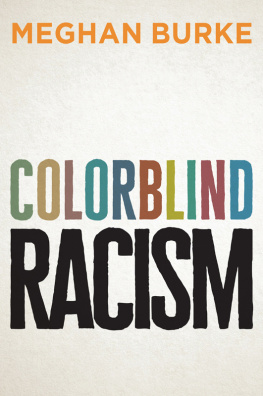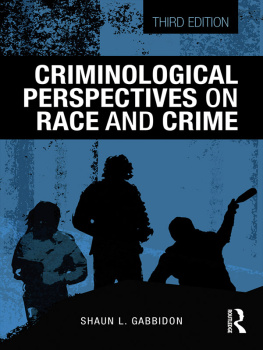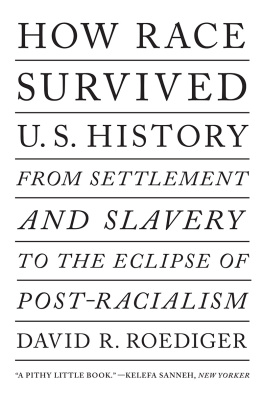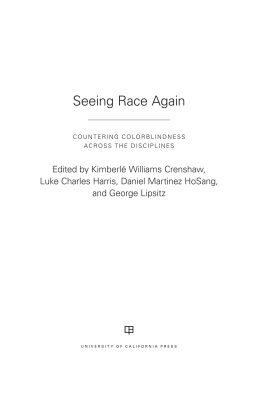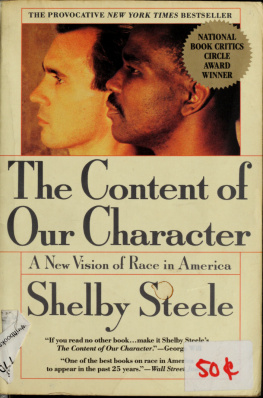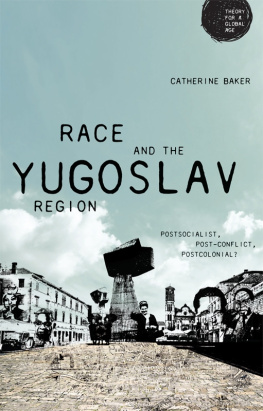BLINDED BY SIGHT
Seeing Race Through the Eyes of the Blind
Osagie K. Obasogie
Stanford Law Books
An Imprint of Stanford University Press
Stanford, California
Stanford University Press
Stanford, California
2014 by Osagie K. Obasogie. All rights reserved.
This book has been partially underwritten by the Stanford Authors Fund. We are grateful to the Fund for its support of scholarship by first-time authors. For more information, please see www.sup.org/authorsfund
No part of this book may be reproduced or transmitted in any form or by any means, electronic or mechanical, including photocopying and recording, or in any information storage or retrieval system without the prior written permission of Stanford University Press.
Printed in the United States of America on acid-free, archival-quality paper
Library of Congress Cataloging-in-Publication Data
Obasogie, Osagie K., author.
Blinded by sight : seeing race through the eyes of the blind / Osagie K. Obasogie.
pages cm
Includes bibliographical references and index.
ISBN 978-0-8047-7278-5 (cloth : alk. paper)
ISBN 978-0-8047-7279-2 (pbk. : alk. paper)
. Race awarenessUnited States. 2. BlindUnited StatesAttitudes. 3. RaceSocial aspectsUnited States. 4. Race discriminationLaw and legislationUnited States. 5. Post-racialismUnited States. 6. United StatesRace relations. I. Title.
E184.A1O19 2013
305.800973dc23
2013013770
ISBN 978-0-8047-8927-1 (electronic)
That Justice is a blind goddess
Is a thing to which we black are wise
Her bandage hides two festering sores
That once perhaps were eyes.
Langston Hughes, 1923
Contents
Acknowledgments
There is simply nothing more important in life than being surrounded by a loving family, supportive friends, and thoughtful colleagues. And, in this regard, I am the luckiest man on earth.
All that I have achieved in life is the result of the loving home and upbringing provided my parents, Dr. A. O. Obasogie and Mrs. Faithe Obasogie, and my sister, Imuetinyan. They have been unbelievably supportive in allowing me to pursue my interests and passions. But they are also most responsible for shaping my sociological imagination and legal sensibilities. I am eternally thankful for their efforts, wisdom, love, and sacrifice in cultivating my curiosities and developing my sense of justice.
This project started around 2005 after I viewed the film Ray, which portrays the life story of the talented musician Ray Charles, who was Black and blind. I was immediately struck by the fact that although Mr. Charles became blind as a young child, he had a remarkably strong sense of race throughout his lifea sense that, in many ways, belied the emphasis on vision that orients sighted peoples understanding of race. I was intrigued by this notion that a blind person could share the same racial sensibility as sighted individuals. At the time, I assumed that this was an active area of scholarly research. I wanted to learn more, so I examined the literature. I was surprised to find that no one had studied blind peoples understanding of race, which speaks to the strength of the assumption that race is self-evidently known and defined by visual cues. After stumbling across this remarkable gap in the literature, I began this research project.
It has been quite a journey. I am first and foremost indebted to the more than one hundred respondents who graciously shared their thoughts and experiences with me. I am always impressed by the courage and kindness that it takes for respondents to tell a complete stranger the most intimate details of their lives. I am also thankful to the advisers and colleagues who have shaped this book into its current form. Lauren Edelman has been amazing; I am deeply appreciative of her patience, guidance, and encouragement throughout this process. Kathryn Abrams, Catherine Albiston, Neil Fligstein, Ian Haney Lpez, Angela Harris, Kristin Luker, Melissa Murray, and Sarah Song also offered remarkable insights that were instrumental in the early development of this project. Several others have also played key roles in helping this project evolve: Ashutosh Bhagwat, Khiara Bridges, Devon Carbado, Benjamin Depoorter, Kimani Paul-Emile, Katherine Franke, Laura Gmez, Cheryl Harris, Jerry Kang, Sonia Katyal, Ethan Leib, Laura Beth Nielson, Dorothy Roberts, Aliya Saperstein, Carroll Seron, Kendall Thomas, and Joan Williams. Katy Chase, Catherine Davidson, and Nancy Zhang provided excellent research assistance. And a special thank-you to Kate Wahl, Michelle Lipinski, Frances Malcolm, Mary Ray Worley, and Tim Roberts at Stanford University Press for their wonderful editorial assistance.
Portions of this book previously appeared in my doctoral dissertation and in these published articles: Osagie K. Obasogie, Do Blind People See Race? Social, Legal, and Theoretical Considerations, 44 LAW & SOCY REV. 585 (2010); Osagie K. Obasogie, The Return of Biological Race? Regulating Race and Genetics Through Administrative Agency Race Impact Assessments, 21 S. CAL. INTERDISC. L. J. 1 (2012); and Osagie K. Obasogie, Can the Blind Lead the Blind? Rethinking Equal Protection Jurisprudence Through An Empirical Examination of Blind Peoples Understanding of Race, 15 U. PA. J. CONST. L. 705 (2012). Many thanks to these journals editors for their tireless work.
I have been quite fortunate to have the opportunity to develop this project as a faculty member at the University of California, Hastings College of the Law, and the University of California, San Francisco (UCSF) Department of Social and Behavioral Sciences (SBS). The faculty, staff, and administration at these institutions have created a wonderful environment for research and writing, and I am forever indebted to them for their support. A special thank you to former UC Hastings Chancellor and Dean Nell Newton, current UC Hastings Chancellor and Dean Frank Wu, UC Hastings Academic Dean Shauna Marshall, former UCSF SBS Department Chair Howard Pinderhughes, and current UCSF SBS Department Chair Ruth Malone for their support throughout this process.
From 2008 through 2010, I was a Visiting Scholar at UCSF Center for Health and Community (CHC). CHC Director Nancy Adler has been an amazing presence in my professional development, and I owe her and many other CHC affiliatesespecially Paula Braveman, Ray Catalano, Robert Hiatt, William Satariano, and S. Leonard Symea tremendous debt of gratitude for allowing me to partake in their remarkably enriching community of scholars. I am also thankful for the opportunity to work with the Center for Genetics and Society, which has in many ways become my second family over the years. Richard Hayes and Marcy Darnovsky are simply two of the best people that I have ever met; their passion for and commitment to social justice has left a lasting imprint on me. Francine Coeytaux, Jessica Cussins, Alexander Gaguine, Charles Garzn, Douglas Pet, Jesse Reynolds, Pete Shanks, Emily Smith Beitiks, and Diane Tober have been wonderful colleagues, and I look forward to our continued work together.
And last but not least, a special thank you to the lovely Ms. Ellis, who has been a devoted partner since the very beginning of this book project.
Preface
I was born and raised in Southwestern Ohio, right along what many consider to be the northernmost edge of the Bible Belt. Like most people in the area, I was raised in a fairly religious household; my parents are devout Christians. Southern Baptists, to be exact. Church attendance every Sunday, if not a time or two during the week, was a foregone conclusion. Our family was active in church life; my father occasionally served on various committees, and I cannot remember a time when my mother did not teach Sunday School.
Next page


